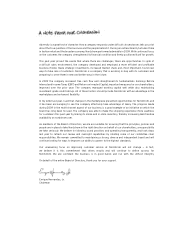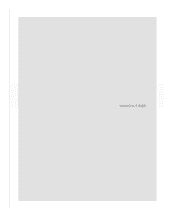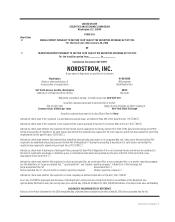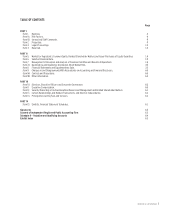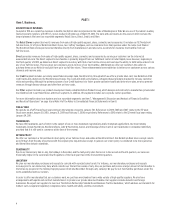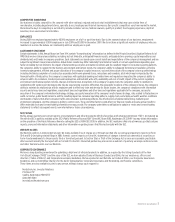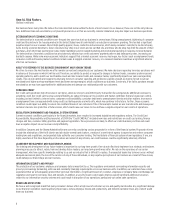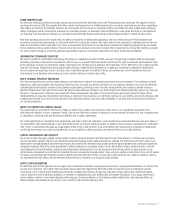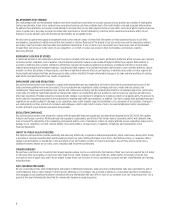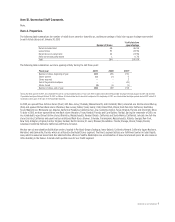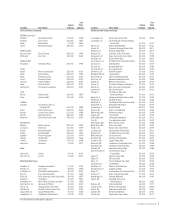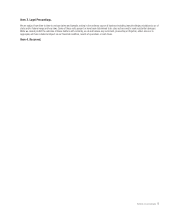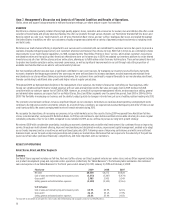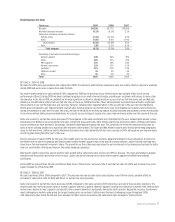Nordstrom 2009 Annual Report Download - page 15
Download and view the complete annual report
Please find page 15 of the 2009 Nordstrom annual report below. You can navigate through the pages in the report by either clicking on the pages listed below, or by using the keyword search tool below to find specific information within the annual report.Nordstrom, Inc. and subsidiaries 7
STORE GROWTH PLANS
Our five-year strategic growth plan includes opening several new full-line and Rack stores, with 30 announced store openings. The majority of these
openings will occur by 2012. We compete with other retailers and businesses for suitable locations for our stores. Local land use and other regulations
may impact our ability to find suitable locations. We also depend on the work of our developer partners to sustain our store growth plans. Developer
delays of shopping center construction, expansion or renovation projects, or developer financial difficulties, could cause the delay or cancellation of
our expected store openings or remodels, or could adversely affect maintenance and leasing at some shopping centers in which we have stores.
New store openings also involve certain risks, including constructing, furnishing and supplying a store in a timely and cost effective manner and
accurately assessing the demographic or retail environment for a particular location. Our future sales at new, relocated or remodeled stores may not
meet our projections, which could affect our return on investment. Performance in our new stores could also be negatively impacted if we are unable
to hire employees who are able to deliver the level of service our customers have come to expect when shopping in our stores. Our inability to execute
our store growth strategy in a way that generates appropriate returns on investment could affect our future growth and profitability.
INFORMATION TECHNOLOGY STRATEGY
We make investments in information technology to sustain our competitive position. In 2010, we expect to spend approximately $160 on information
technology operations and systems development, which is key to our growth. We must monitor and choose the right investments and implement them
at the right pace. Excessive technological change could impact the effectiveness of adoption, and could make it more difficult for us to realize benefits
from the technology. Targeting the wrong opportunities, failing to make the best investments, or making an investment commitment significantly
above or below our needs may result in the loss of our competitive position. In addition, if we do not maintain our current systems we may see
interruptions to our business and increase our costs in order to bring our systems up to date.
MULTI-CHANNEL STRATEGY EXECUTION
Over the past several years, we have made changes in our business to improve the shopping experience across all channels. These changes included
aligning our online merchandise offering with our full-line stores to create a seamless experience for our customers between our stores and Web site,
combining the full-line stores’ and Direct merchandise organizations; providing a more focused catalog offering; and creating a shared inventory
platform between Direct and our full-line stores. We plan to make additional changes in our multi-channel merchandise planning process over the next
few years. If we encounter challenges associated with change management, the ability to hire and retain key personnel involved in these efforts,
implementation of associated information technology, or adoption of new processes, our ability to continue to successfully execute this strategy could
be adversely affected. As a result, we may not derive the expected benefits to our sales and profitability, or we may incur increased costs relative to
our current projections.
IMPACT OF COMPETITIVE MARKET FORCES
The retail industry environment continues to change for many of our vendors and customers. In the future, our competition may partner more
effectively with vendors to serve consumers’ needs. If we do not effectively respond to changes in our environment, we may see a loss of market share
to competitors, declining sales and declining profitability due to higher markdowns.
Our credit segment faces competition from large banks, and other credit card companies, some of which have substantial financial resources. Many of
our competitors offer general-purpose credit card products with a variety of loyalty programs. In addition, there is intense competition for cardholders
with “prime” credit ratings who make up a significant portion of our credit portfolio. If we do not effectively respond to the competitive banking and
credit card environment, we could lose market share to our competitors, which would have an adverse effect on our credit business.
CAPITAL MANAGEMENT AND LIQUIDITY
Our access to debt and equity capital, and our ability to invest capital to maximize the total returns to our shareholders, is critical to our long-term
success. We utilize capital to finance our operations and working capital, make capital expenditures, manage our debt levels and return value to our
shareholders through dividends and share repurchases. As a result of the financial crisis, global credit and equity markets have undergone significant
disruption, making it difficult for many businesses to obtain financing on acceptable terms or at all. Our ability to obtain capital and the cost of the
capital depend on financial market conditions and independent rating agencies’ short and long-term debt ratings, which are based largely on our
performance as measured by credit metrics including interest coverage and leverage ratios. If our access to capital is restricted or if our cost of capital
increases, our operations and financial condition could be adversely affected. Further, if we do not properly allocate our capital to maximize returns,
our operations and cash flows could be adversely affected and our long-term cost of capital could increase.
SUPPLY CHAIN DISRUPTION
The effective and efficient operation of our supply chain, including merchandise sourcing and procurement, receiving and distribution, is critical to the
success of our business. Our supply chain operations may be adversely impacted by difficulties with our suppliers, such as production capacity
constraints, errors in meeting merchandise specifications, including specifications dictated by consumer product safety laws, insufficient quality
control, failures to meet production deadlines, or increases in manufacturing costs. Additionally, unforeseen disruptions in our supply chain due to
severe weather, natural or man-made disasters, labor disputes, shipping problems, or information systems malfunction, may adversely affect our
ability to deliver merchandise to our stores or our customers and could increase our costs.



